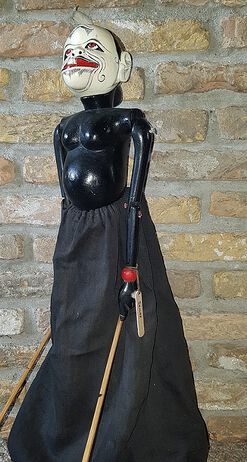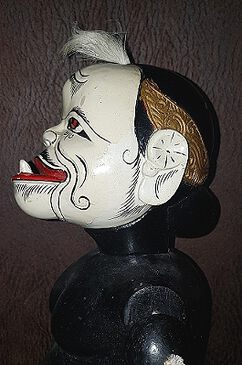Semar
| Title | Semar - (Betara - Panakawan) - All stories |
|---|---|
| Other names | Semarasanta, Dewa Kasimpar, Ismaya, Badranaya, Nayantaka, Dewa Lelana |
| Size | 60 cm |
| Personal data | Semar (Betara Ismaya) is a God, brother of Betara Manikmaya (Guru), son of the One and Only Lord. Semar should not actually be called a clown. He is equal to the gods, sometimes even more powerful. Under the name Ismaya, he is sometimes the father and other times the older brother of Siwa. Semar is married to Dewi Sutiragen and Dewi Kanastren. He has nine children, all of whom belong to the gods. He is also called the father of Petruk, Gareng and Cepot. In other stories they are his younger companions. |
| Appearance | Semar always humbled himself towards his foster children and spoke softly as a servant should, when talking to his master. But if he hangs out with the Gods, he behaves like he is facing his equals. |
| Collection | Private collection |
Semar - (Betara - Panakawan) - All stories
Sang Hyang Tunggal considers Semarlah the old man and predicts that he will not be able to associate with the Gods and orders, so that he stays in the world to nurture the descendants of the Gods who are embodied and human. After Semar lived in Marcapada (the world), his appearance changed from good to very ugly. All signs of ugliness in the human body were found in Semar, so that Semar was considered an ordinary human being.
Semar always follows and supports the descendant of God named Pendawa. Semar has a patient, loving, affectionate character and is never in trouble. But when he gets angry, no one can stop him and he considers the gods lower than the soles of his feet. Signs that when he is angry are tears streaming down his eyes, his snot flowing profusely and his farts coming out incessantly, while he screams at God, asking for his good looks to return. Semar symbolizes true human morals.
Semar with secretive eyes (sore eyes), nose (like a celery tuber), the lower lip of the mouth is quite long, crested, herniated, ringed, both hands can be moved, but always behind the back. Big ass sticking out the back. Semar cengeng, easy to cry. If the knight he accompanies faces danger, he cries, but his crying is sung by using wangsalan, saying vague words and containing meaning such as in the words: roning mlinjo (the name of the mlinjo leaf is aso). Then the words of roning mlinjo were continued with the words: sampun sayah begged for a rest, I'm tired please rest.
When crying in the face of danger, Semar said as follows: Lae my flag father, please Raden sami nyenthe gap", senthe gap means: Kajar, a nation of tales that grow in the gap. And continue those words with: Mangga Raden sami lumajar which means. Let's come, Raden and we are together.
In the play Srikandi learns archery, at one point Arjuna mistakenly supported Dewi Wara Sumbadra who was angry, because he thought Sumbadra was Srikandi and at that time Arjuna was infatuated with Srikandi. This mistake angered Sumbadra and he said to Anjuna, "Come quickly, return my body to Dwarawati. I came here first because of you. I am not in a hurry to hand over my body to you, Madukara people and only hand it over because you invited him." This event happened because of Semar, because it was Semar who informed Sumbadra of Srikandi's location. Then in his turn Arjuna got angry with Semar and after Semar got angry with Arjuna, he said, "As long as Raden who has clear vision can make mistakes, even more so a servant with blurry eyes, is certainly more likely to make mistakes. That is just an overview of Raden Arjuna's behavior.
Even now, events like this can happen too. When played in the afternoon, the Semar puppet used is one whose face and body are painted in red, and when played in the morning, the puppet whose face is painted white and whose body is black is used. Where Semar is played together with his two sons, Gareng and Petruk, then Semar takes the form of: 1. Gilut, 2. Dunuk, 3. Watu, 4. Mega, 5. Shaman, 6. Miling, and 7. Brebes.
It is said that Semar, which has this color, was written by Sri Sultan Agung in Mataram. Meanwhile, Semar is played with Bagong, Brebes and Jetung.
Source: History of Wayang Purwa - Hardjowirogo - PN Balai Pustaka - 1982


